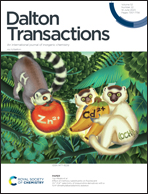Efficient emission of Zn(ii) and Cd(ii) complexes with nopinane-annelated 4,5-diazafluorene and 4,5-diazafluoren-9-one ligands: how slight structural modification alters fluorescence mechanism†
Abstract
Zinc(II) and cadmium(II) chlorido complexes with an N,N-chelating nopinane-annelated 4,5-diazafluoren-9-one ligand (LO) were synthesized. While the zinc(II) complex is mononuclear and adopts a tetrahedral ZnN2Cl2 coordination geometry, its cadmium(II) analogue features a 1D polymeric structure due to the bridging coordination of chlorido ligands with Cd2+ ions having an octahedral CdN2Cl4 coordination geometry. The photophysical properties of the oxygen-containing LO ligand and its zinc(II) and cadmium(II) complexes were studied in solution and in the solid state and matched against the properties of its oxygen-free 4,5-diazafluorene congener L and its complexes of the same metal ions. Comprehensive experimental and theoretical studies revealed the impact of the oxygen atom in the ligand core on the luminescence of the ligands and the complexes. For the oxygen-free L ligand and L-based complexes, the structural differences between the S0 and S1 geometries are small, which leads to fluorescence with extraordinarily small Stokes shifts. The emission of these compounds is of locally excited character for L and of mixed locally excited + ligand-to-halide charge transfer character for the L-based complexes. The introduction of the oxygen atom in the ligand core results in a drastic red-shift of the emission band due to short-range charge transfer. The differences between the S0 and S1 geometries are much more pronounced for LO and LO-based compounds than those of their oxygen-free analogues, leading to an order of magnitude larger Stokes shifts. On going from solution to the solid state, LO and its complexes exhibit aggregation-induced emission (AIE) behaviour with photoluminescence quantum yields (PLQYs) reaching tens of percent.



 Please wait while we load your content...
Please wait while we load your content...